#polar stratospheric clouds (psc)
Explore tagged Tumblr posts
Text



Polar Stratospheric Clouds (PSCs Type II), aka Pearl/Nacreous Clouds, Enontekiö, Finland, 18 Jan '25. Photos © Ritva Reinilä. Images 4, 3 and 5 from a set of 8.
#Ritva Reinilä#photography#PSCs#polar stratospheric clouds#pearl clouds#nacreous clouds#Finland#cosmic skies & clouds
10 notes
·
View notes
Text
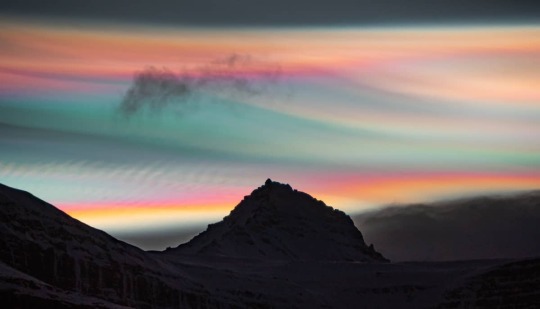
Rare Rainbow Clouds Appear in Iceland Thanks To Freezing Temperatures
Photographer: Jónína Guðrún Óskarsdóttir
These polar stratospheric clouds (PSC) paint the sky with different colored stripes. PSCs are a type of wave cloud that are most often found downwind of mountain ranges. As expected, Óskarsdóttir's stunning rainbow cloud images feature prominent mountains. The colorful clouds form when the lower stratosphere hits -114°F (-81°C).

#jonina guorun oskarsdottir#photographer#rainbow clouds#clouds#iceland#polar stratospheric clouds (psc)#wave cloud#landscape#nature
52 notes
·
View notes
Text
On Sunday, December 17, the Polar stratospheric clouds were seen all over Finland!
Polar stratospheric clouds (PSCs) are clouds in the winter polar stratosphere at altitudes of 15,000–25,000 m (49,000–82,000 ft). They are best observed during civil twilight, when the Sun is between 1 and 6 degrees below the horizon, as well as in winter and in more northerly latitudes. Wikipedia
#Iltasanomat#Suomi#Finland#Clouds#Polar stratospheric cloud#Polar stratospheric clouds#PSC#PSCs#Stratosphere#Civil twilight#Winter#Helmiäispilvi#Helmiäispilvet#Pilvet#Stratosfääri#suomitumppu#suomi tumppu#suomitumblr#suomi tumblr
3 notes
·
View notes
Text
The most important reactions leading eventually to the destruction of ozone on PSCs are those that form HNO3, H2O and Cl2 from ClONO2, HCl and N2O5 through the intermediate HOCl.

"Chemistry" 2e - Blackman, A., Bottle, S., Schmid, S., Mocerino, M., Wille, U.
#book quote#chemistry#nonfiction#textbook#ozone layer#ozone#polar stratospheric cloud#psc#chlorine#nitrogen#oxygen#hydrogen#hydrochloric acid#chlorine nitrate#nitric acid#water#hypochlorous acid#dinitrogen pentoxide#nitrogen pentoxide#nitric anhydride#chemical reactions
0 notes
Text



Stunning polar stratospheric clouds (PSCs) over Iceland.
(📸©️theourspace)
206 notes
·
View notes
Text





Polar stratospheric clouds (PSCs) are clouds in the winter polar stratosphere at altitudes of 15,000–25,000 m (49,000–82,000 ft). They are best observed during civil twilight, when the Sun is between 1 and 6 degrees below the horizon, as well as in winter and in more northerly latitudes. One main type of PSC is made up mostly of supercooled droplets of water and nitric acid and is implicated in the formation of ozone holes. The other main type consists only of ice crystals which are not harmful.
2 notes
·
View notes
Link
0 notes
Text


Foreign Office Government Kingdom of Switzerland as UNGeneva
Date :. 24.11.2023
Country :. Belgium
In attendance today
Chief of Staff PC7:. Lt Col Daniel Stämpfli
Guest Prime Minister Alexander De Croo
House of Schwarzburg-Burgdorf SwissUN H.S.H Princess Isabel M Neuchatel Presenting & Prayer Chapel Clock Swiss Movement For:. 12 Religions
Public Health Swissness Serene Highness Project:. Snow (Water) Production for for Food & Mineral
Restoration & Regeneration of :. Principality of Flanders House of Léopold
United Nations & Inter-Parliamentary Union Constitutional Amendments:.
Presidential and Principality
Hereditary Dutch of Flanders
Snow (Water) Production in Belgium for food and mineral Resources
1. Polar stratospheric clouds (PSCs) migration charts must match in Spring, Summer, Autumn, and winter.
2. Managing Microclimate of a country use transport that produces hydrocarbons.
3. Farms closer to main road for pollination by public transport on highways prevent the shrinking of the stratosphere to produce snow and rain clouds.
4. Town Planning Positioning the farms as a perimeter water moat defence to prevent town flooding and putting parks in the middle and greenhouse and factory farming.
5. Municipal Boarders planning for carbon:
Carbon permissions Afforestation by water moats which we dredge of crop seedlings.
Carbon denial of permission Peatland, Bioenergy crops
Switzerland's foreign policy is driven by interests in peace and security strengthening the Multilateral relationship with the UN and Parliament action on global climate and environmental protection and strengthening international digital governance. The Bourgeoisie of Geneva in the Age of the Reformation and Restoration
#swissness#security#agriculture#climate change#service#electricity#water#business#grant#automation#climate action#belgium#Switzerland
0 notes
Text

One of the most magical experiences of my life.
Iridescencent clouds (polar stratospheric clouds) in Norway 4th of January 2020.
Sadly, this type of cloud can contribute to holes in the Ozone layer. A dangerous beauty.
#naturecore#Polar stratospheric cloud#psc#iridesence#magical#mother earth#narceous#in awe#nature is amazing#nature
3 notes
·
View notes
Text
POLAR STRATOSPHERIC CLOUDS
Arctic skies are filling with color today--but it's not the aurora borealis. A rare outbreak of polar stratospheric clouds (PSCs) is underway. Jónína Óskarsdóttir photographed the display from Fáskrúðsfjörður, Iceland:

We have been seeing these clouds for a couple of days," reports Óskarsdóttir. "In this picture, Mt. Jökultindur is silhouetted by a sky-full of nacreous color."
Polar stratospheric clouds are rare. Earth's stratosphere is very dry and normally it has no clouds at all. PSCs form when the temperature in the Arctic stratosphere drops to a staggeringly-low -85 C. Then, and only then, can widely-spaced water molecules begin to coalesce into tiny ice crystals. High-altitude sunlight shining through the crystals creates intense iridescent colors often likened to auroras.
NASA models of the polar stratosphere show that temperatures have indeed dropped into the very low range required for Type II PSCs:

However, the forecast (yellow) calls for warming as January comes to an end, so now is the time to look. During a typical Arctic winter, PSCs appear no more than two or three times. If you see one, it's definitely worth taking a picture.
more images: from Fredrik Broms of Kvaløya, Norway; from Jónína Óskarsdóttir of Fáskrúðsfjörður, Iceland; from Francois Guilhaume-Bohl of Nellim, Finland From Spaceweather.com 1/24/23
13 notes
·
View notes
Photo

Nacreous (‘mother of pearl’) cloud Nacreous clouds, also known as polar stratospheric clouds (PSCs), appear high in the atmosphere, some 15 to 30km (10 to 20 miles) above the Earth, generally in latitudes higher than 50°, particularly in the northern hemisphere. They form in the freezing temperatures of the lower stratosphere, often below -80°C (-112°F), and are usually a mixture of nitric acid and ice crystals, sourced from parcels of moist air that are forced up through the tropopause by the same orographic oscillations that are responsible for producing high lenticular wave clouds.
The likeliest time to see them is during a winter sunrise or sunset, when most of the sky is dark, leaving them lit by the sun from beneath the horizon. Their iridescent pastel colours can be magically beautiful, an effect heightened by their enormous distance from the viewer. But there is a dark side to these iridescent wave clouds: their chemical composition assists the production of chlorine atoms, which in turn contributes to the depletion of the ozone layer, 25km (15 miles) above the Earth, where nacreous clouds are mostly found. A single chlorine atom can destroy up to 100,000 ozone molecules (O3)—which is why the large-scale release of chlorofluorocarbons (CFCs) into the atmosphere was to prove such a disaster— so, sadly, these most beautiful and benign-looking clouds turn out to have a powerfully destructive environmental impact. ~ JM Image Credit: http://bit.ly/1LqD32g retrieved on 23/06/15. Labelled for reuse More Info: Toon, O. B., & Turco, R. P. (1991). Polar stratospheric clouds and ozone depletion. Scientific American, 264(6), 68-74. Stanford, J. L. (1973). On the physics of stratospheric (nacreous) cloud formation. Tellus, 25(5), 479-482. Polar stratospheric cloud: http://bit.ly/1AS5UGI
#cloud#winter#atmosphere#arctic#iridescent#tropopause#air#science#chemistry#chlorine#ozone#the earth story#polar stratospheric clouds#nacreous#clouds
201 notes
·
View notes
Text

Polar Stratospheric Clouds over Hale Village, near Liverpool, UK. Photo by Vincent Phillips, 21 Dec '23.
#Vincent Phillips#photography#polar stratospheric clouds#PSCs#nacreous clouds#pearl clouds type II (ice)#cosmic skies & clouds
3 notes
·
View notes
Photo
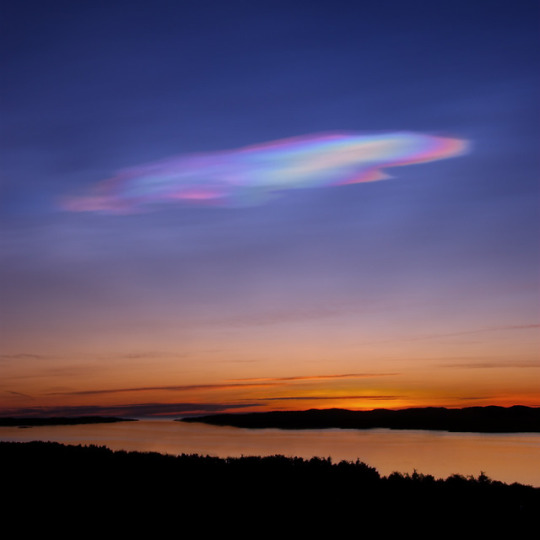
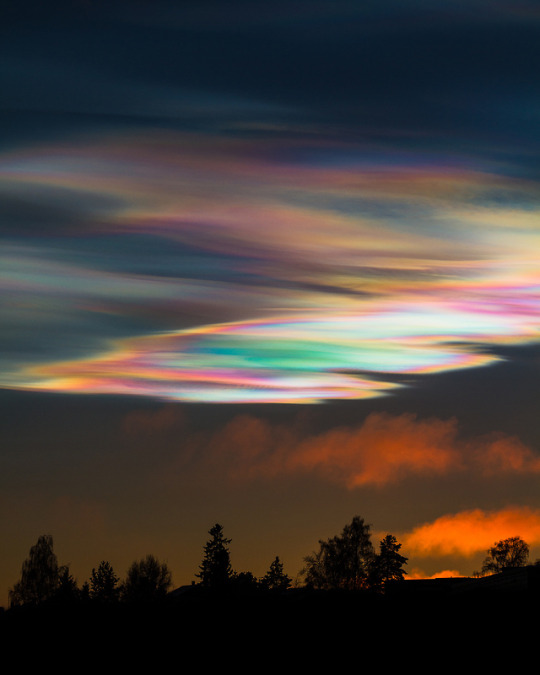
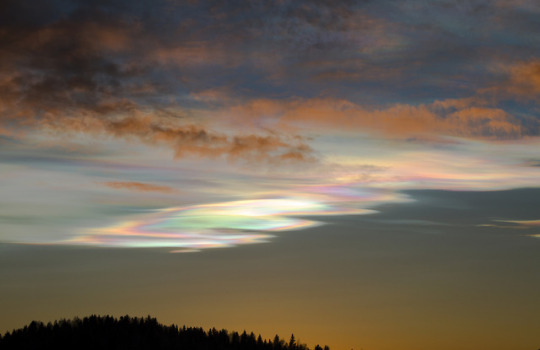
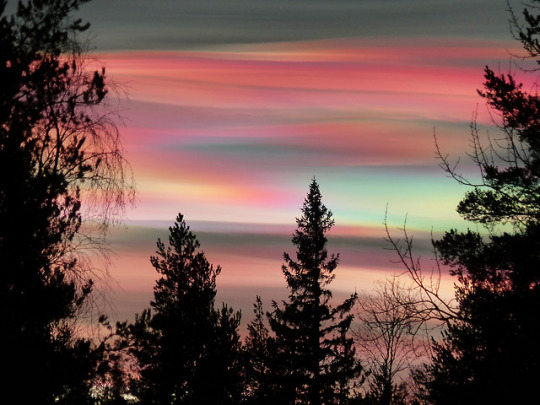
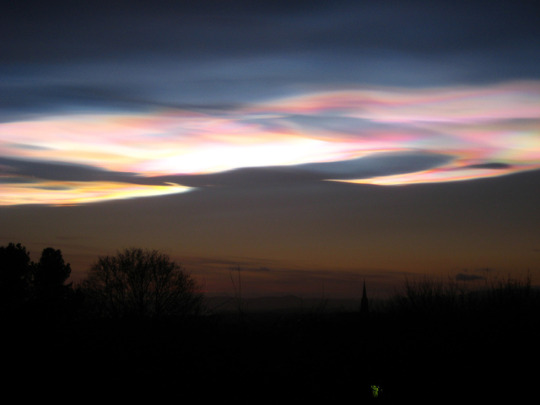
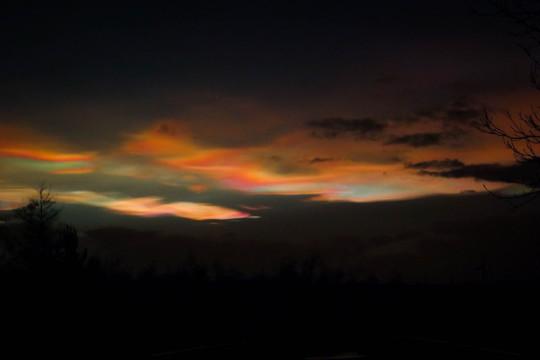
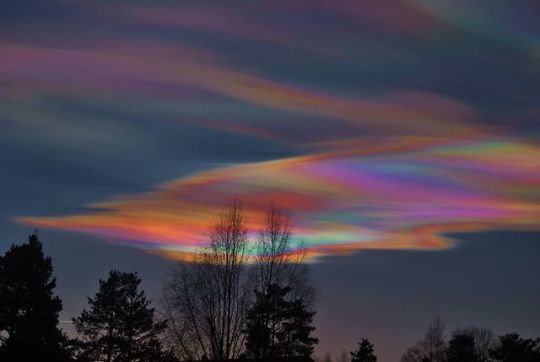
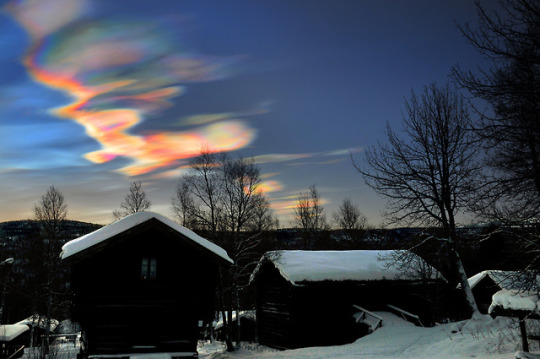
Polar stratospheric clouds or PSCs, also known as nacreous clouds, are clouds in the winter polar stratosphere at altitudes of 15,000–25,000 meters (49,000–82,000 ft). They are best observed during civil twilight when the sun is between 1 and 6 degrees below the horizon as well as in winter and in more northerly latitudes. They are implicated in the formation of ozone holes. The effects on ozone depletion arise because they support chemical reactions that produce active chlorine which catalyzes ozone destruction, and also because they remove gaseous nitric acid, perturbing nitrogen and chlorine cycles in a way which increases ozone destruction.
source / images: x, x, x, x, x, x, x, x
5K notes
·
View notes
Text
okay this is a bit of an oversimplification of the situation, as it is a fixed problem that is a current issue. so the ozone hole over the Antarctic occurs only during part of the year, specifically the spring following the Antarctic winter. it is seasonal due to the climate being so unbearably cold (-80°C) that it allows the formation of polar stratospheric clouds (PSCs) which act as a catalyst for the depletion of O3, since it activates a free radical (chlorine) that destroys O3 on a 100,000:1 (O3:Cl). however, we found the culprit, chlorofluorocarbons (CFCs or freons 11&12), which were commonly found in refrigerants and coolants and completely banned them in the 1984 Montreal Protocol (with a total ban in 2010). due to the nature of the stratosphere, recovery is slow since it’s so high up and there’s so much Cl free radical buildup that can’t be removed fast enough, so full recovery is projected to happen in 2100 (or 2070 if we’re being good to our environment). unfortunately even though it is a solved problem, this just isn’t one of the environmental problems that can get resolved quickly once legislation is put in place (and I am a chem scientician)
its really really fucked up that people in the global north think? assume? are told? that the ozone hole closed & went away forever & isnt a problem anymore
the ozone hole closes and opens every year and at no point has it stopped. 2020 was one of the worst years on record for both size and length of opening. there has been a trend downwards over the last decade, but the ozone hole absolutely didnt stop being a problem. aotearoa and australia have the world's worst rates of skin cancer. (australia's number is higher overall, but aotearoa is higher per capita.)
i dont really have any kind of moral to this post just please be aware that the ozone hole is very much still a problem and not something you can put in the 'solved' basket. it still massively affects the lives of people in the far south and the idea that it's permanently closed is false.
(please do not ask me any followup questions i am not some kind of scientician im just a guy who got sunburned through jeans one time on a long car trip)
14K notes
·
View notes
Text







Sometimes we get iridescent "mother-of-pearl clouds" or, more scientifically, polar stratospheric clouds here. We've had them almost every day for the past couple weeks, which is really unusual! They're rare because they're in the stratosphere, the layer of the atmosphere above the one we (and most clouds) live in, the troposphere. The troposphere has a lot of moisture, while the stratosphere is very dry, hence clouds don't usually form there. But sometimes when it's cold enough (reason why they form in polar regions in winter), ice crystals can get pushed into the stratosphere and then they make pretty shimmery rainbow clouds.
Sadly, PSCs are not actually a good thing... they often contain chloro-fluoro-carbons, or CFCs, famously the chemicals that were banned in the 80s because of the ozone hole. So PSCs do actually destroy ozone, which is... not great. But they sure are pretty. I thought you guys might like some gay clouds :) They're even more colorful in person! It's hard to get a good picture.
#rainbow clouds#the polar sky is an lgbtq+ ally doncha know#this finally worked uploading from my computer ugh
0 notes
Video
youtube
JANUARY 10, 2020 PSC- POLAR STRATOSPHERIC CLOUDS AT LOWER ALTITUDES
0 notes